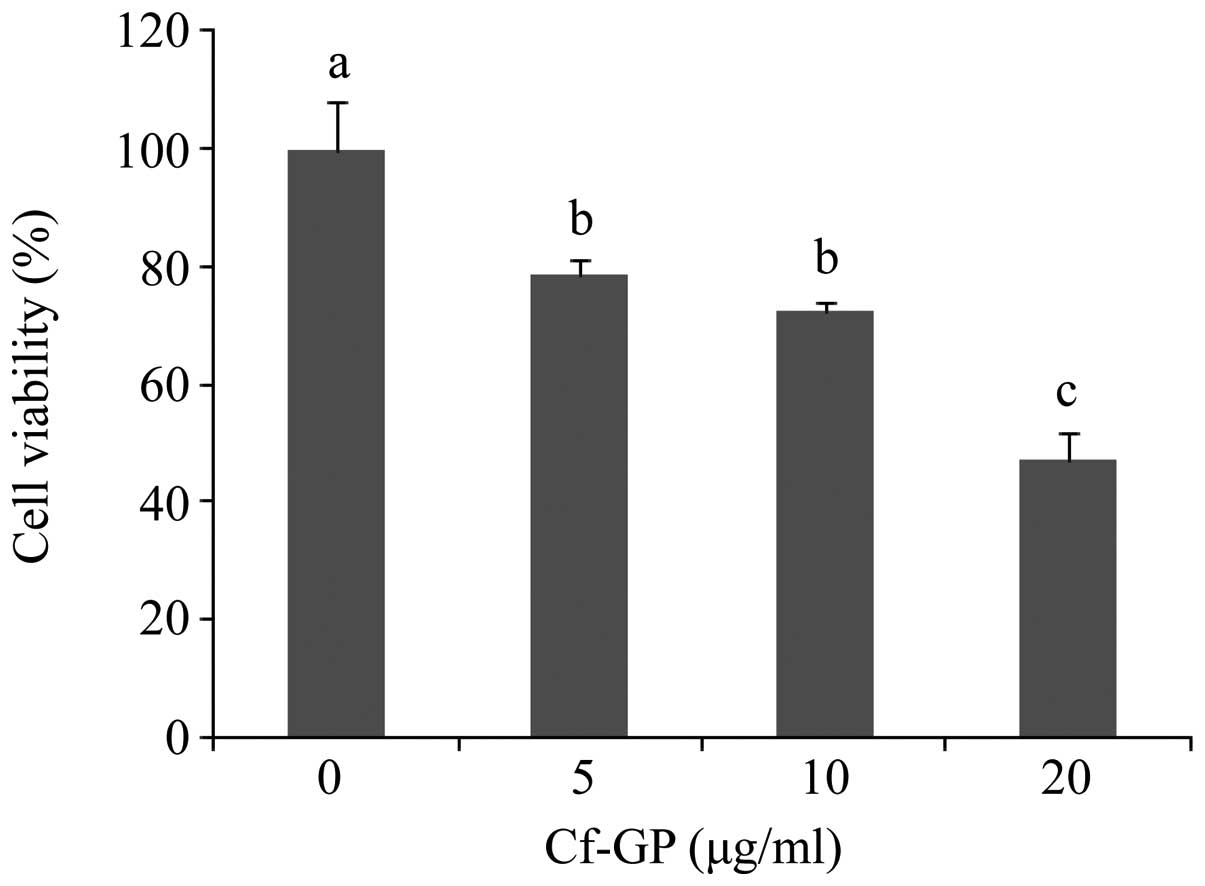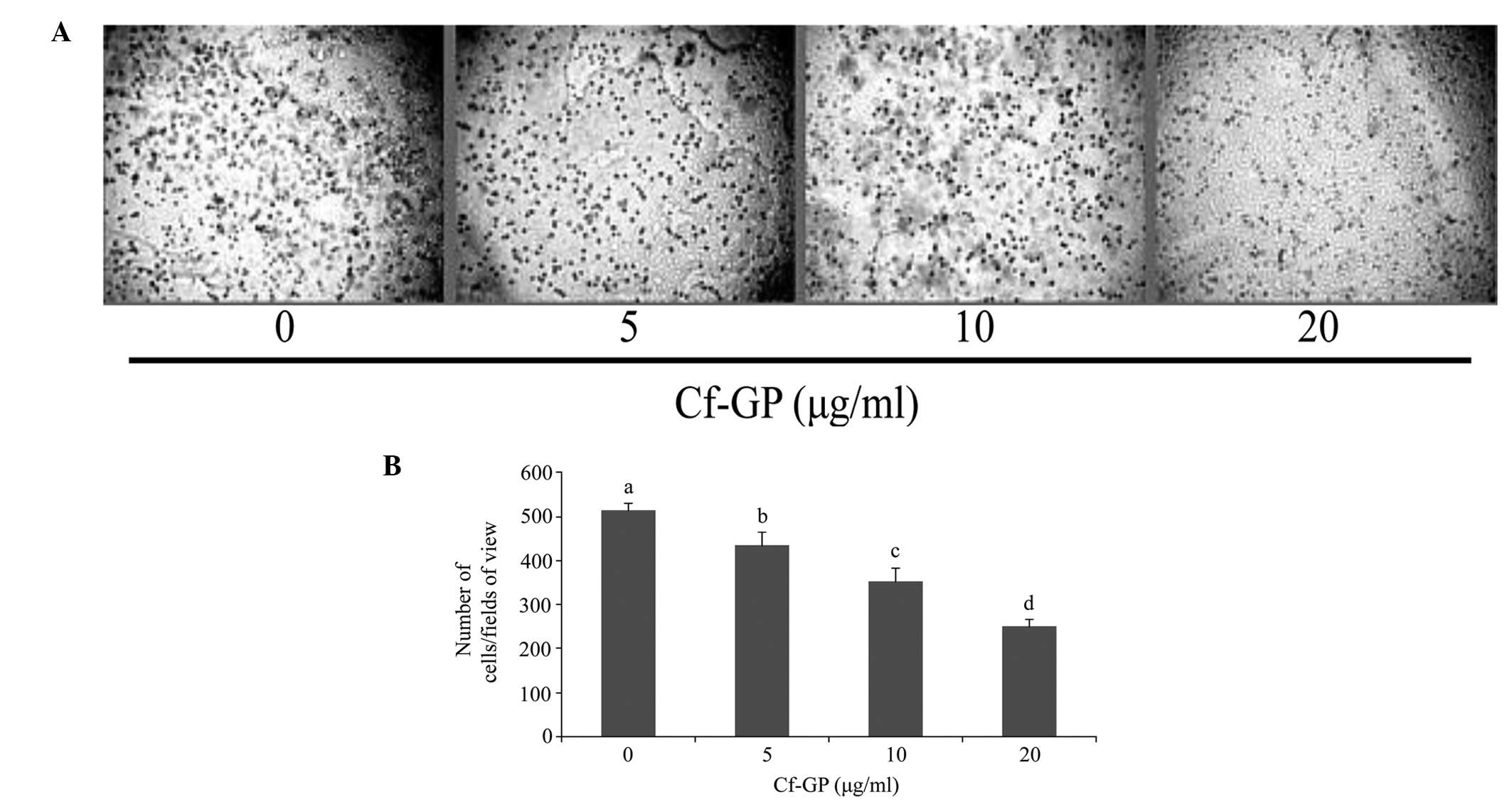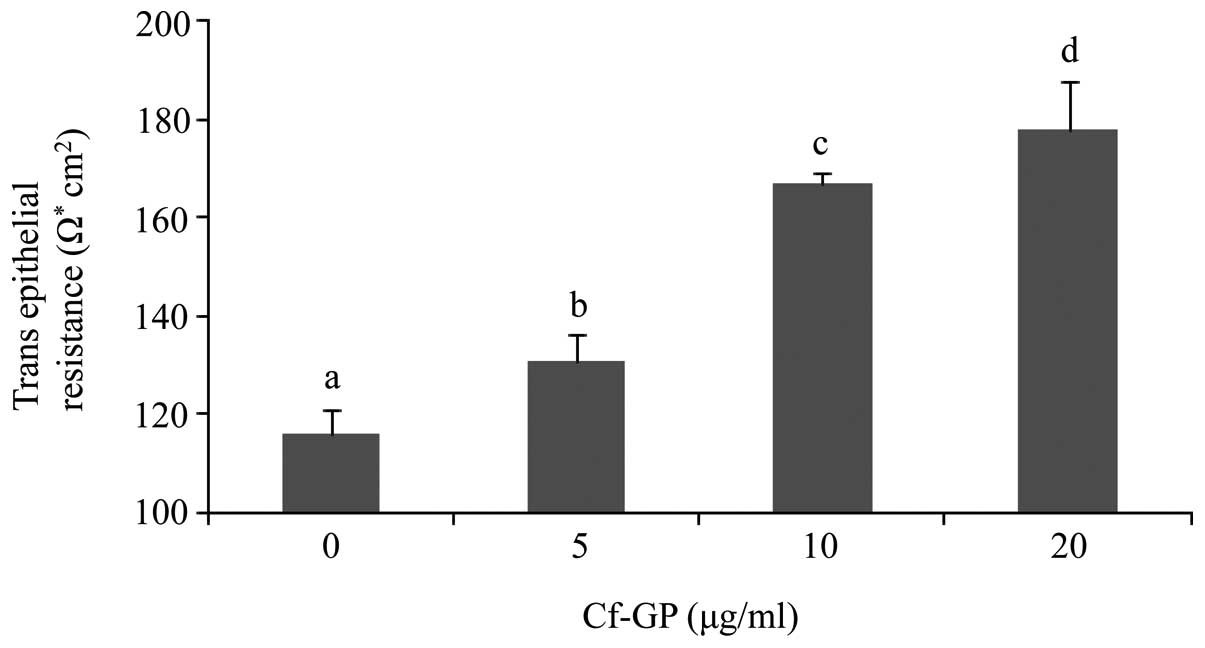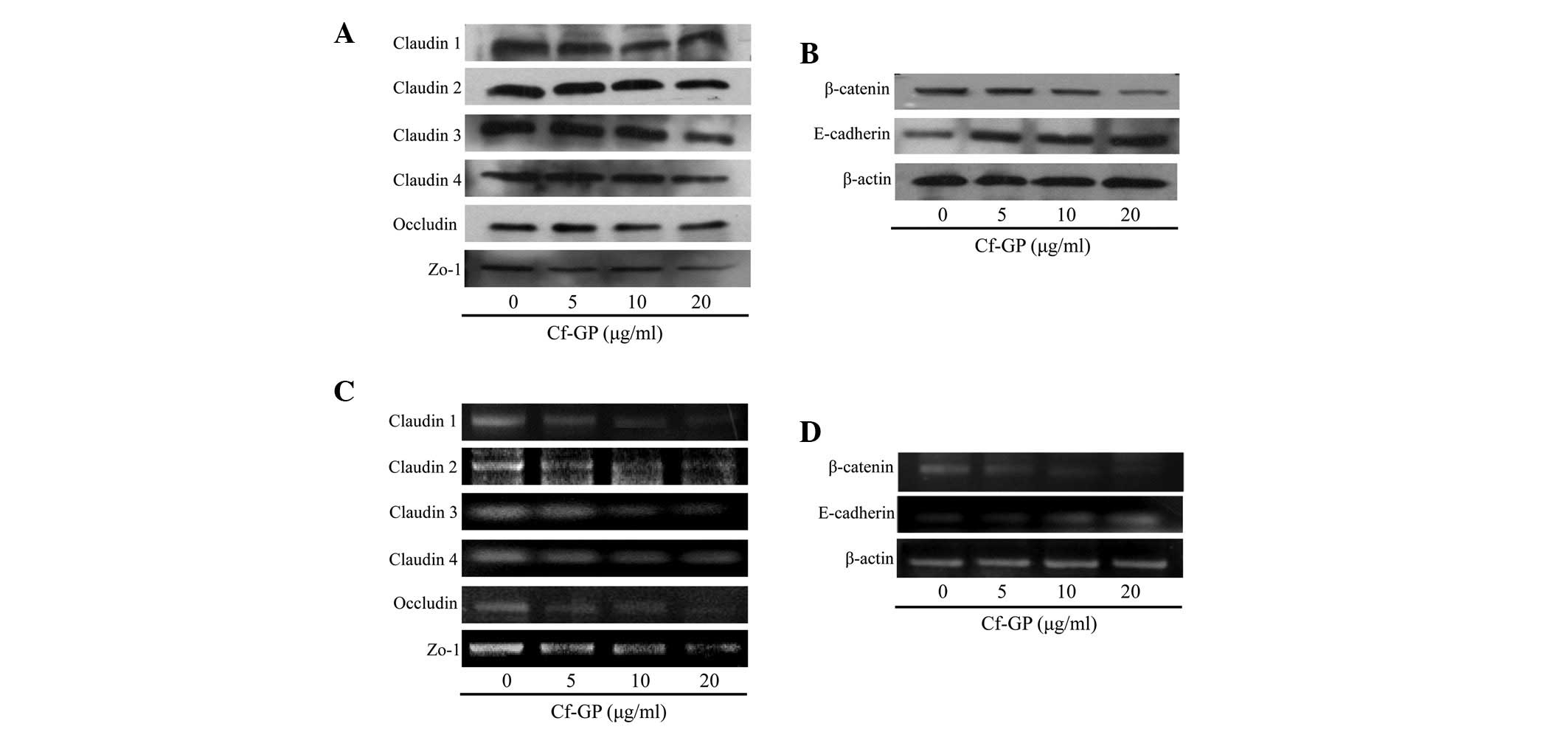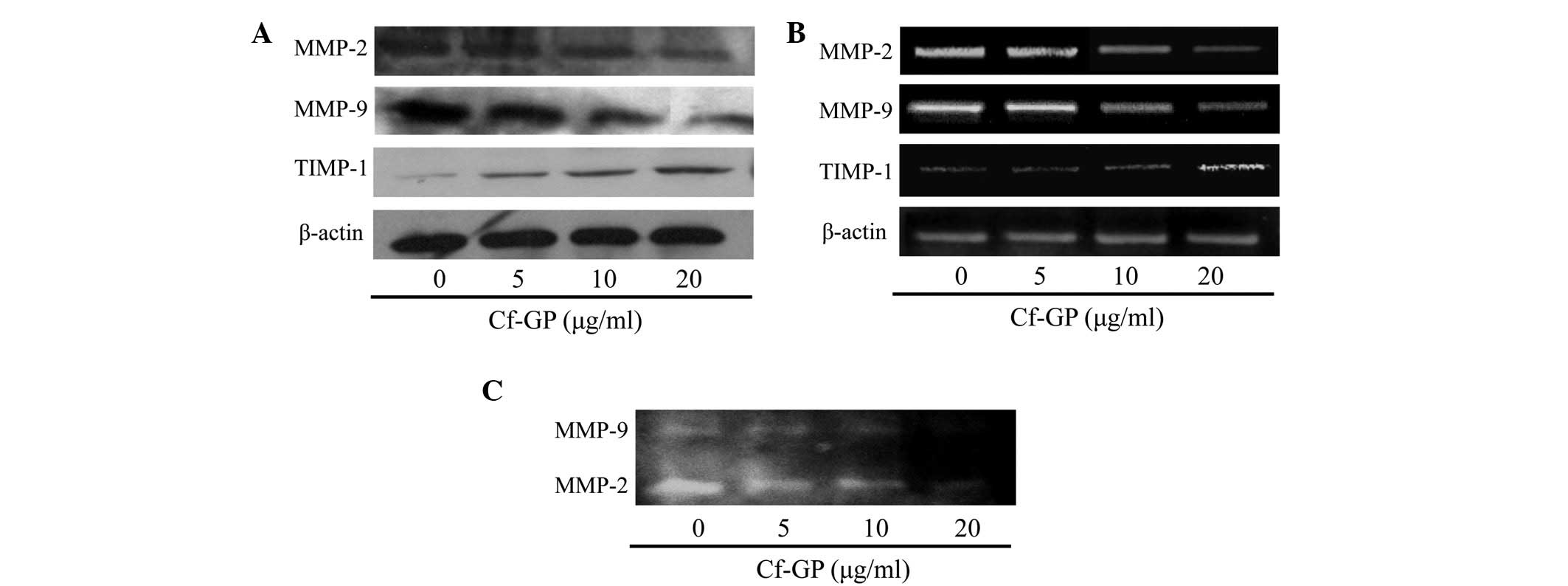|
1
|
Bishop JM: The molecular genetics of
cancer. Science. 235:305–311. 1987. View Article : Google Scholar : PubMed/NCBI
|
|
2
|
Kim SO, Choi YH and Choe WK:
Indol-3-carbinol regulated tight junction permeability and
associated-protein level and suppressed cell invasion in human
colon cancer cell line, HT-29. Korean J Nutr. 41:13–21. 2008.
|
|
3
|
Higashi-Okaj K, Otani S and Okai Y: Potent
suppressive effect of a Japanese edible seaweed, Enteromorpha
prolifera (Sujiao-nori) on initiation and promotion phases of
chemically induced mouse skin tumorigenesis. Cancer Lett.
140:21–25. 1999.PubMed/NCBI
|
|
4
|
Okai Y, Higashi-Okai K, Nakamura S, Yano Y
and Otani S: Suppressive effects of the extracts of Japanese edible
seaweeds on mutagen-induced umu C gene expression in Salmonella
typhimurium (TA 1535/pSK 1002) and tumor promoter-dependent
ornithine decarboxylase induction in BALB/c 3T3 fibroblast cells.
Cancer Lett. 87:25–32. 1994. View Article : Google Scholar : PubMed/NCBI
|
|
5
|
Yamamoto I, Maruyama H and Moriguchi M:
The effect of dietary seaweeds on
7,12-dimethylbenz[a]anthracene-induced mammary tumorigenesis in
rats. Cancer Lett. 35:109–118. 1987.
|
|
6
|
Noda H, Amano H, Arashima K and Nisizawa
K: Antitumor activity of marine algae. Hydrobiologia. 204–205.
577–584. 1990.
|
|
7
|
Kwon MJ and Nam TJ: Porphyran induces
apoptosis related signal pathway in AGS gastric cancer cell lines.
Life Sci. 79:1956–1962. 2006. View Article : Google Scholar : PubMed/NCBI
|
|
8
|
Go H, Hwang HJ and Nam TJ: A glycoprotein
from Laminaria japonica induces apoptosis in HT-29 colon
cancer cells. Toxicol in Vitro. 24:1546–1553. 2010.
|
|
9
|
Hwang HJ, Kim IH and Nam TJ: Effect of a
glycoprotein from Hizikia fusiformis on
acetaminophen-induced liver injury. Food Chem Toxicol.
46:3475–3481. 2008.PubMed/NCBI
|
|
10
|
Choi YH: Inhibition of cell invasion by
ethyl alcohol extracts of Hizikia fusiforme in AGS human
gastric adenocarcinoma cells. Korea J Life Sci. 20:1784–1791. 2010.
View Article : Google Scholar
|
|
11
|
Cho EK, Yoo SK and Choi YJ: Inhibitory
effects of maesaengi (Capsosiphon fulvescens) extracts on
angiotensin converting enzyme and α-glucosidase. Korea J Life Sci.
21:811–818. 2011.
|
|
12
|
Park HY, Lim CW, Kim YK, Yoon HD and Lee
KJ: Immunostimulating and anti-cancer activities of hot water
extract from Capsosiphon fulvescens. J Korean Soc Appl Biol
Chem. 49:343–348. 2006.
|
|
13
|
Kim YM, Kim IH and Nam TJ: Induction of
apoptosis signaling by a glycoprotein of Capsosiphon
fulvescens in AGS cell. Kor J Fish Aquat Sci. 44:216–224.
2011.
|
|
14
|
Peralta SA, Mullin JM, Knudsen KA and
Marano CW: Tissue remodeling during tumor necrosis factor-induced
apoptosis in LLC-PK1 renal epithelial cells. Am J Physiol.
270:F869–F879. 1996.PubMed/NCBI
|
|
15
|
Swift JG, Mukherjee TM and Rowland R:
Intercellular junctions in hepatocellular carcinoma. J Submicrosc
Cytol. 15:799–810. 1983.PubMed/NCBI
|
|
16
|
Van Itallie CM and Anderson JM: The
molecular physiology of tight junction pores. Physiology
(Bethesda). 19:331–338. 2004.PubMed/NCBI
|
|
17
|
Kim YM, Kim IH and Nam TJ: Induction of
apoptosis signaling by glycoprotein of Capsosiphon
fulvescens in human gastric cancer (AGS) cells. Nutr cancer.
64:761–769. 2012. View Article : Google Scholar : PubMed/NCBI
|
|
18
|
Lamszus K, Kunkel P and Westphal M:
Invasion as limitation to anti-angiogenic glioma therapy. Acta
Neurochir Suppl. 88:169–177. 2003.PubMed/NCBI
|
|
19
|
Duffy MJ, Maguire TM, Hill A, McDermott E
and O'Higgins N: Metalloproteinases: role in breast carcinogenesis,
invasion and metastasis. Breast Cancer Res. 2:252–257. 2000.
View Article : Google Scholar : PubMed/NCBI
|
|
20
|
Curry JD, Glaser MC and Smith MT:
Real-time reverse transcription polymerase chain reaction detection
and quantification of t(1;19)(E2A-PBX1) fusion genes associated
with leukemia. Br J Haematol. 115:826–830. 2001. View Article : Google Scholar : PubMed/NCBI
|
|
21
|
Park HS, Kim GY, Choi IW, Kim ND, Hwang
HJ, Choi YW and Choi YH: Inhibition of matrix metalloproteinase
activities and tightening of tight junctions by diallyl disulfide
in AGS human gastric carcinoma cells. J Food Sci. 76:T105–T111.
2011. View Article : Google Scholar : PubMed/NCBI
|
|
22
|
Coussens LM and Werb Z: Matrix
metalloproteinases and the development of cancer. Chem Biol.
3:895–904. 1996. View Article : Google Scholar : PubMed/NCBI
|
|
23
|
Bennett JH, Morgan MJ, Whawell SA, Atkin
P, Roblin P, Furness J and Speight PM: Metalloproteinase expression
in normal and malignant oral keratinocytes: stimulation of MMP-2
and MMP-9 by scatter factor. Eur J Oral Sci. 108:281–291. 2000.
View Article : Google Scholar : PubMed/NCBI
|
|
24
|
Ylisirniö S, Höyhtyä M and
Turpeenniemi-Hujanen T: Serum matrix metalloproteinases −2, −9 and
tissue inhibitors of metalloproteinases −1, −2 in lung
cancer-TIMP-1 as a prognostic marker. Anticancer Res. 20:1311–1316.
2000.
|
|
25
|
Song ES, Lee BI, Kim JM, Lee KY, An KS,
Sung SM, Kwon HJ, Park JH, Han JY and Choi SJ: Increase expressions
of claudin-1 and claudin-7 in cervical squamous intraepithelial
neoplasias and invasive squamous cell carcinomas. Korean J Obstet
Gynecol. 49:1065–1072. 2006.
|
|
26
|
Langbein L, Grund C, Kuhn C, Praetzel S,
Kartenbeck J, Brandner JM, Moll I and Franke WW: Tight junctions
and compositionally related junctional structures in mammalian
stratified epithelia and cell cultures derived therefrom. Eur J
Cell Biol. 81:419–435. 2002. View Article : Google Scholar
|
|
27
|
Tsukita S and Furuse M: Pores in the wall:
claudins constitute tight junction strands containing aqueous
pores. J Cell Biol. 149:13–16. 2000. View Article : Google Scholar : PubMed/NCBI
|
|
28
|
Agarwal R, D'Souza T and Morin PJ:
Claudin-3 and claudin-4 expression in ovarian epithelial cells
enhances invasion and is associated with increased matrix
metalloproteinase-2 activity. Cancer Res. 65:7378–7385. 2005.
View Article : Google Scholar : PubMed/NCBI
|
|
29
|
Balda MS, Garrett MD and Matter K: The
ZO-1-associated Y-box factor ZONAB regulates epithelial cell
proliferation and cell density. J Cell Biol. 160:423–432. 2003.
View Article : Google Scholar : PubMed/NCBI
|
|
30
|
Lee H, Kim D, Sohn D, Jeong B, Choi H, Sim
K, Lee K, Cho H, Kim S, Lee J, Jeong Y, Kim S, Lee W and Kim K: The
changes of occludin in tight junction of blood-brain barrier by
ROS. Korean J Electron Microscopy. 34:231–239. 2004.
|
|
31
|
Tunggal JA, Helfrich I, Schmitz A, Schwarz
H, Günzel D, Fromm M, Kemler R, Krieg T and Niessen CM: E-cadherin
is essential for in vivo epidermal barrier function by regulating
tight junctions. EMBO J. 24:1146–1156. 2005. View Article : Google Scholar : PubMed/NCBI
|
|
32
|
Mess ST, Mennigen R, Spieker T, Rijcken E,
Senninger N, Haier J and Bruewer M: Expression of tight and
adherens junction proteins in ulcerative colitis associated
colorectal carcinoma: upregulation of claudin-1, claudin-3,
claudin-4 and β-catenin. Int J Colorectal Dis. 24:361–368.
2009.PubMed/NCBI
|



